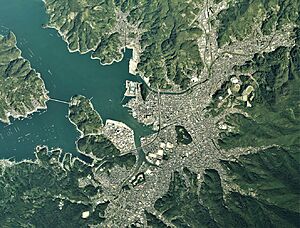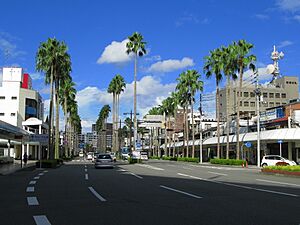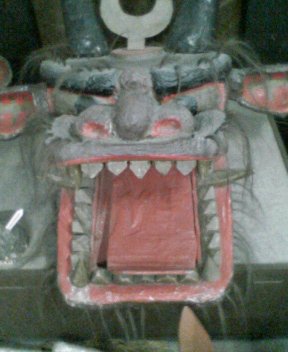Uwajima, Ehime facts for kids
Quick facts for kids
Uwajima
宇和島市
|
|||||||||||
|---|---|---|---|---|---|---|---|---|---|---|---|
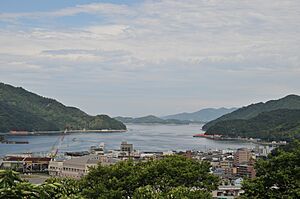
View of Uwajima Bay and downtown Uwajima from Uwajima Castle
|
|||||||||||
|
|||||||||||
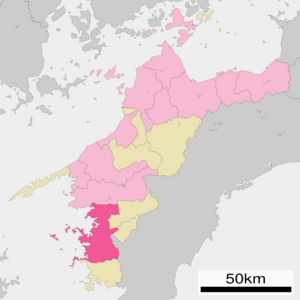 |
|||||||||||
| Country | Japan | ||||||||||
| Region | Shikoku | ||||||||||
| Prefecture | Ehime | ||||||||||
| Area | |||||||||||
| • Total | 468.19 km2 (180.77 sq mi) | ||||||||||
| Population
(September 1, 2022)
|
|||||||||||
| • Total | 70,440 | ||||||||||
| • Density | 150.452/km2 (389.67/sq mi) | ||||||||||
| Time zone | UTC+09:00 (JST) | ||||||||||
| City hall address | 1 Akebonochō, Uwajima-shi, Ehime-ken 798-8601 | ||||||||||
| Climate | Cfa | ||||||||||
|
|||||||||||
Uwajima (宇和島市 (Uwajima-shi)) is a city located in Ehime Prefecture, Japan. As of September 1, 2022, about 70,440 people lived in Uwajima. The city covers an area of 468.19 square kilometers (180.77 square miles).
Contents
Discovering Uwajima's Location and Surroundings
Uwajima is in the southwestern part of Ehime Prefecture. It faces the beautiful Uwa Bay, which is part of the Seto Inland Sea. The city has a unique coastline with many inlets and islands. Mountains surround Uwajima on its other three sides.
Nearby Towns and Cities
Uwajima shares borders with several other places.
Ehime Prefecture:
- Kihoku
- Matsuno
- Seiyo
Kōchi Prefecture:
- Shimanto city
- Sukumo
Understanding Uwajima's Climate
Uwajima has a humid subtropical climate. This means it has hot summers and cool winters. It rains a lot throughout the year, but especially from June to September.
Exploring Uwajima's Population Changes
The number of people living in Uwajima has slowly gone down since the 1960s.
| Historical population | ||
|---|---|---|
| Year | Pop. | ±% |
| 1960 | 132,146 | — |
| 1970 | 111,648 | −15.5% |
| 1980 | 110,920 | −0.7% |
| 1990 | 105,030 | −5.3% |
| 2000 | 95,641 | −8.9% |
| 2010 | 84,210 | −12.0% |
| 2020 | 70,809 | −15.9% |
A Look at Uwajima's Past
The area where Uwajima is today was once part of an old Japanese province called Iyo Province.
Early History and Challenges
During the Heian period, the island of Hiburijima in Uwajima Bay was a center for pirates. A famous rebel, Fujiwara no Sumitomo, even used it as his base.
Later, in the Muromachi period, the Saionji family was in charge. They faced many attacks from stronger neighbors. They managed to survive for a long time by changing their loyalties and fighting hard.
From Warring States to Modern City
Eventually, the Chōsokabe clan took control, but they were soon defeated by Toyotomi Hideyoshi. Hideyoshi was a powerful leader who unified Japan.
After this, Tōdō Takatora became the ruler of the area. He was a skilled castle designer. He spent six years building Itajima Castle, which is now known as Uwajima Castle.
In 1614, Date Hidemune, the son of the famous warrior Date Masamune, became the lord of Uwajima. His family ruled Uwajima until the Meiji restoration in the late 1800s. This was a time when Japan changed a lot.
The modern city of Uwajima was officially created in 1921. It grew by combining with nearby villages over the years. The city center was badly damaged during World War II in 1945. However, it was rebuilt quickly after the war. In 2005, Uwajima grew even more by joining with the towns of Mima, Tsushima, and Yoshida.
Understanding Uwajima's Economy
Uwajima is the biggest city in southwestern Ehime. Its main industries are commercial fishing, especially using the unique coastline, and aquaculture (fish farming). They also produce cultured pearls. There is also a shipyard in the city.
Education in Uwajima
Uwajima has 30 public elementary schools and six public middle schools. These are run by the city government. There are also five public high schools, which are managed by the Ehime Prefectural Board of Education.
Getting Around Uwajima
Railways
![]() Shikoku Railway Company - Yosan Line
Shikoku Railway Company - Yosan Line
- Tachima - Iyo-Yoshida - Takamitsu - Kita-Uwajima - Uwajima
![]() Shikoku Railway Company - Yodo Line
Shikoku Railway Company - Yodo Line
- Ōuchi - Futana - Iyo-Miyanoshita - Muden - Kita-Uwajima - (Uwajima)
Highways
 Matsuyama Expressway
Matsuyama Expressway National Route 56
National Route 56 National Route 320
National Route 320 National Route 378
National Route 378 National Route 381
National Route 381
Ports
- Port of Uwajima
Fun Things to See and Do in Uwajima
- Uwajima Castle is one of only 12 castles in Japan that still has its original main tower from the Edo Period.
- The Date Family Museum shows many important items from the history of the Date family, who ruled this area.
- The Uwajima Ushi-oni Festival is also called the "Gaiya Festival." It happens in July. During the festival, teams parade with large "ushioni" (cow demon) figures. There's also a dance contest and traditional dancing. The word "Gaiya" means "awesome" in the local language.
- Uwajima is famous for its bullfighting. This is different from Spanish bullfights because there is no matador. Two bulls fight in a ring until one bull's knees touch the ground or it runs away. Bullfights usually happen in January, April, July, and August.
- Ryūkō-ji is the 41st temple on the Shikoku Pilgrimage.
- Butsumoku-ji is the 42nd temple on the Shikoku Pilgrimage.
Exploring Tsushima
Tsushima is a large area that is now part of Uwajima. It has many small villages. Tsushima is known for the Iwamatsu River and its yearly festival. It is also famous for pearl and fish farming. Tsushima is part of the prefecture's mikan (tangerine) industry.
Famous People from Uwajima
- Umetaro Azechi: A Japanese printmaker and mountain climber.
- Masafumi Hirai: A Japanese professional baseball pitcher.
- Kazuyoshi Ishii: A Japanese martial arts master and founder of the K-1 fighting circuit.
- Daisuke Itō: A Japanese film director and screenwriter.
- Akinori Iwamura: A Japanese baseball manager and former infielder.
- Kyoichi Katayama: The author of the novel Socrates in Love, which was made into a movie.
- Kenta Kawai: A Japanese former football player.
- Susumu Koshimizu: A Japanese sculptor and installation artist.
- Shingo Matsumoto: A Japanese amateur Greco-Roman wrestler.
- Ryuji Miyade: A former professional baseball outfielder.
- Shinro Ohtake: A contemporary Japanese artist who lives and works in Uwajima.
- Masayoshi Ōishi: A Japanese musician and singer-songwriter.
- Tetchō Suehiro: A Japanese politician, novelist, and journalist.
- Mutsumi Tamabayashi: A Japanese football player.
- Sho Tanaka: A Japanese professional wrestler.
- Raymond Ken'ichi Tanaka: A Bishop of the Roman Catholic Diocese of Kyoto.
- Koichi Yamamoto: A Japanese politician and member of the House of Representatives.
- Haruhiro Yamashita: A Japanese gymnast and two-time Olympic gold medalist.
Gallery
See also
 In Spanish: Uwajima (Ehime) para niños
In Spanish: Uwajima (Ehime) para niños






